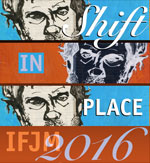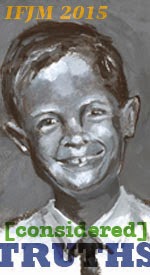Susan Jolly participated in the 2014 International Fake Journal Month celebration by creating in a quad ruled journal.
Susan wrote about her journal choice in a post saying that
I wanted everything to be as easy as possible so of course I planned to choose a journal I already had. When I opened the drawer where I keep most of my new and partially-used journals, I was delighted to find this marble cover—80 sheet composition book that I'd forgotten about. I'd bought it when we were on vacation last fall when I saw it in one of those drug stores that sells everything and just had to have it. I had only used the first dozen pages for a trip diary.
It turned out to be perfect for my IFJM project! It's a No. 77227 hard-cover sewn [!] 5x5 Quad Ruled 9.75x7.5 in. rounded corner notebook made in the U.S.A. by Roaring Spring Paper Products. It opens flat. The sheets are sturdy but very thin so almost anything except pencil or ballpoint pen bleeds through. Nonethless they feel lovely and the pages make a cheering noise when you turn them. I really liked this size: large enough to put quite a bit on a page if you want to but small enough that a half-filled page doesn't look empty.She also wrote that she found it was "freeing and enjoyable to write on quad-ruled paper." (I'm guessing future real journals may be kept in similar books.)
Her character Anne is a couple years younger than Susan. She is described as a wonderful person, gentle, thoughtful, creative. She sews, cooks, and is very organized. As Susan "friend" she encourages a memory exchange between them.
Anne of course knows that most of us have mixed memories of loved ones but she said that I might want to capture some of the happy ones I have of my father. I was hesitant about how to do this until she suggested that she'd make a quick phone call to me every day and ask for one memory. She then grabs the closest writing instrument and jots down her summary of what I've told her in a composition book she had on hand that happened to have only a few pages already written on. She's also been adding sketches and ideas for the memory book which she plans to make when IFJM is over.With this artistic conceit in place, Susan was able to complete her project and make an entry each day in April. She attributes her success to limiting herself on materials. She needed only her journal and a writing implement, whatever was at hand. (There were times she did add some collage material.)
Susan wrote that this created a big advantage—it kept her working:
Typically when I try to do any art activity including art journaling, I spend more time hopping up and down and looking for stuff than I spend actually working. (I should note I'm not usually this way when doing other creative activities.) I've tried limiting materials but this hasn't worked very well for me in the past. There are of course numerous other approaches that have the potential to improve this situation. I hope to use the momentum from my IFJM project to discover which of these approaches work best for me.Susan wrote two additional posts on her blog about wrap up which can be found at this link.
In those posts you'll find additional insights that Susan's project brought to her. I encourage you to go and check them out. She had a very valuable insight into her relationship with her journals.
When I look back at journals I've done, they typically make me glad that I've done them whether or not I particularly enjoyed doing them at the time. This is in contrast to looking at individual pieces of art later because I usually don't like them any better than when I did them.But what I enjoyed reading the most was that her character came up with creative solutions even when she was having difficulty. "This means that I am capable of coming up with creative solutions."
I think that's something that we all need to remind ourselves of every day!












2 comments:
Susan's plan was to make everything as easy as possible and I believe that's key when journaling daily.
And what better than to discover we're more creative than we thought! Good work Susan!
I like Susan's character idea, and her well thought out plan of how to execute it.
Post a Comment